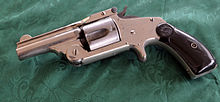
A revolver is a repeating handgun that has at least one barrel and uses a revolving cylinder containing multiple chambers for firing. Because most revolver models hold up to six cartridges, before needing to be reloaded, revolvers are commonly called six shooters or sixguns. Due to their rotating cylinder mechanism, they may also be called wheel guns.

Smith & Wesson Brands, Inc. (S&W) is an American firearm manufacturer headquartered in Maryville, Tennessee, United States.

The Colt Single Action Army is a single-action revolver handgun. It was designed for the U.S. government service revolver trials of 1872 by Colt's Patent Firearms Manufacturing Company and was adopted as the standard-issued pistol of the U.S. Army from 1873 to 1892.

The Smith & Wesson Model 29 is a six-shot, double-action revolver chambered for the .44 Magnum cartridge and manufactured by the United States company Smith & Wesson.

Ethan Allen was a major American arms maker from Massachusetts. He is unrelated to the revolutionary Ethan Allen. His first firearm, the "Pocket rifle" was developed in 1836, and his first patent was granted in 1837.
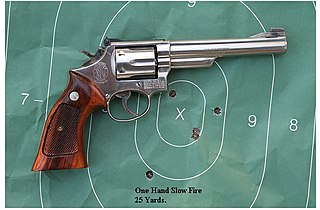
The Smith & Wesson Model 19 is a revolver produced by Smith & Wesson that was introduced in 1957 on its K-frame. The Model 19 is chambered for .357 Magnum. The K-frame is somewhat smaller and lighter than the original N-frame .357, usually known as the Smith & Wesson Model 27. A stainless steel variant of the Model 19, the Smith & Wesson Model 66, was introduced in 1971.

The Smith & Wesson Model 10, previously known as the Smith & Wesson .38 Hand Ejector Model of 1899, the Smith & Wesson Military & Police or the Smith & Wesson Victory Model, is a K-frame revolver of worldwide popularity. In production since 1899, the Model 10 is a six-shot, .38 Special, double-action revolver with fixed sights. Over its long production run it has been available with barrel lengths of 2 in (51 mm), 3 in (76 mm), 4 in (100 mm), 5 in (130 mm), and 6 in (150 mm). Barrels of 2.5 inches (64 mm) are also known to have been made for special contracts. Some 6,000,000 of the type have been produced over the years, making it the most-produced handgun of the 20th century.

Harrington & Richardson Arms Company is an American brand of firearms and a subsidiary of JJE Capital Holdings. H&R ceased independent production February 27, 2015.

In American English, a pocket pistol is any small, pocket-sized semi-automatic pistol, and is suitable for concealed carry in a pocket or a similar small space.

The Smith & Wesson Model 15, initially the Smith & Wesson K-38 Combat Masterpiece, is a six-shot double-action revolver with adjustable open sights produced by Smith & Wesson on the medium-size "K" frame. It is chambered for the .38 Special cartridge and is fitted with a 4-inch (100 mm) barrel, though additional barrel options have been offered at various times during its production. It is essentially a shorter barrel version of the Smith & Wesson Model 14 and an adjustable-sight version of the seminal Smith & Wesson Model 10 with target shooting features.
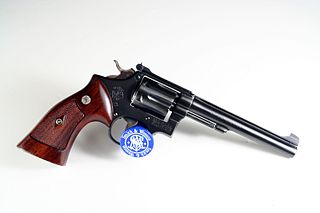
The Smith & Wesson Model 17 is a six-shot double-action revolver chambered for .22 LR. It is built on Smith & Wesson's medium-sized K-frame.
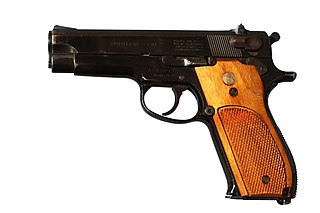
The Smith & Wesson Model 39 is a semi-automatic pistol developed for the United States Army service pistol trials of 1954. After the Army abandoned its search for a new pistol, the Model 39 went on the civilian market in 1955 and was the first of Smith & Wesson's first generation semi-automatic pistols.

A snubnosed revolver is a small, medium, or large frame revolver with a short barrel, generally less than 4 inches in length. Smaller such revolvers are often made with "bobbed" or "shrouded" hammers and there are also "hammerless" models ; the point is to allow the gun to be drawn with little risk of it snagging on clothing. Since the external movement of the mechanism is minimal or nil, shrouded and hammerless models may be fired from within clothing. The design of these revolvers compromises range and accuracy at a distance in favor of maneuverability and ease of carry and concealment.

The Colt Detective Special is a six-shot, carbon steel framed, 2-inch (5.1 cm) or 3-inch (7.6 cm) barreled, double-action revolver, and the first example of a class of firearms known as "snubnose revolvers". Made by Colt's Manufacturing Company, this model revolver, as the name "Detective Special" suggests, was intended to be a concealed weapon used by plainclothes police detectives.

A handgun is a firearm designed to be usable with only one hand. It is distinguished from a long gun which needs to be held by both hands and braced against the shoulder. Handguns have shorter effective ranges compared to long guns, and are much harder to shoot accurately. While most early handguns are single-shot pistols, the two most common types of handguns used in modern times are revolvers and semi-automatic pistols, although other handguns such as derringers and machine pistols also see infrequent usage.
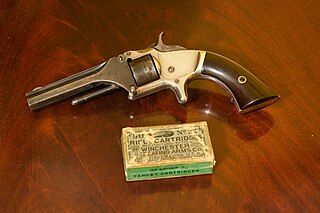
The Smith & Wesson Model 1 was the first firearm manufactured by Smith & Wesson, with production spanning the years 1857 through 1882. It was the first commercially successful revolver to use rimfire cartridges instead of loose powder, musket ball, and percussion caps. It is a single-action, tip-up revolver holding seven .22 Short black powder cartridges.

The Colt Official Police is a medium frame, double-action revolver with a six-round cylinder, primarily chambered for the .38 Special cartridge, and manufactured by the Colt's Manufacturing Company. Released in 1908 as the Colt Army Special, the revolver was renamed the "Colt's Official Police" in 1927 in order to better market to law enforcement agencies. It became one of the bestselling police firearms of all time, eventually coming to exemplify typical law enforcement officer weaponry in the 1950s. The Official Police was also used by various U.S. and allied military forces during World War II.

The Colt New Service is a large frame, large caliber, double-action revolver made by Colt from 1898 until 1941. Made in various calibers, the .45 Colt version with a 5½" barrel, was adopted by the U.S. Armed Forces as the Model 1909.

Merwin, Hulbert, and Co. or Merwin Hulbert was an American firearms designer and marketer based in New York City which produced revolvers and rifles from 1874 to 1896. The firearms were manufactured by a subsidiary company, Hopkins & Allen of Norwich, Connecticut. Merwin Hulbert's designs had influenced other gunmakers of the time, such as Meriden Firearms Co., Harrington & Richardson, Forehand & Wadsworth, and Iver Johnson.

The Smith & Wesson Model 1+1⁄2 was Smith & Wesson's second .32 caliber revolver, intended to combine the small size and convenience of the .22 caliber Model 1 with the larger caliber of the 6-shot "belt sized" Model 2, which was introduced in 1861. Chambered in .32 Rimfire, its cylinder held 5 shots. It was produced in three varieties from 1865 through 1892, with total production exceeding 223,000.
